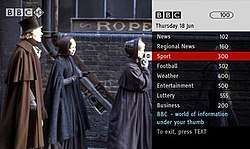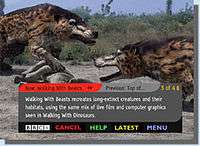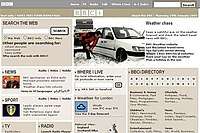BBC Red Button
BBC Red Button is a branding used for digital interactive television services provided by the BBC, and broadcast in the United Kingdom. The services replaced Ceefax, the BBC's analogue teletext service. BBC Red Button's text services were due to close on 30 January 2020, but the switch off was suspended on 29 January 2020 following protests.[1]
| BBC Red Button | |
|---|---|
 BBC Red Button+ logo | |
| Launched | September 1999 |
| Owned by | BBC |
| Picture format | 576i (16:9 SDTV) 1080i (HDTV) |
| Audience share | 0.10% (All BBC Red Button feeds) (September 2018, BARB) |
| Country | United Kingdom |
| Language | English |
| Formerly called | BBC Text (1999–2001) BBCi (2001–2008) |
| Replaced | Ceefax |
| Sister channel(s) | BBC One BBC Two BBC Three (online) BBC Four BBC News BBC Parliament CBBC CBeebies |
| Website | www |
Availability | |
| Terrestrial | |
| Freeview | Channels 601–606 (1-6) |
| Satellite | |
| Freesat | Channel 980 (HD) Channels 981–986 (1-6) |
| Sky (UK only) | Channel 981 (HD) Channels 982–987 (2-6, 1) |
| Cable | |
| Virgin Media | Channel 990 (HD) Channels 991–996 (1-6) |
| Streaming media | |
| TVPlayer | Watch live (UK only) |

History and branding
The service was launched in September 1999 as BBC Text. It was relaunched in November 2001 under the BBCi brand and operated under this name until late 2008, when it was rebranded as BBC Red Button. The "red button" name refers to the common interface on remote controls for digital televisions and set-top boxes, a red push-button which launches digital teletext services.
Although initially marketed as a spectacular new form of television, by 2008 this had given way to positioning iTV as ‘everyday’. This was due in part to the institutional landscape of television in the UK.[2]
In September 2009, the BBC celebrated 10 years of the digital interactive TV service.[3]
BBC Text (1999–2001)
BBC Text originally launched on digital terrestrial services in September 1999, and was later introduced on satellite and cable platforms. In the first phase, the service was created using content migrated from the existing analogue teletext service, Ceefax. A digital text service had been available since the launch of digital terrestrial television in November 1998, but the BBC Text service was not publicly launched until November 1999, due to a lack of availability of compatible set-top boxes. [4]
BBC Text was considerably more advanced than Ceefax, in that it offered a richer visual interface, with the possibility of photographic images and designed graphics (as opposed to Ceefax graphics which were composed of simple blocks of colour). BBC Text also enabled channel association, the ability for the user to retain their selected television channel visible in one section of the screen whilst viewing the text service, in contrast to Ceefax, which could only be viewed as a full-screen display, or as a semitransparent overlay (i.e. opaque blocks of colour on top of the television channel, with the black background now transparent; not 'translucent blocks of colour with a translucent black background') above the television picture. The original text service had no return path, this being made available in later phases.
BBC Text pioneered an early form of "on-demand" interactive television, called Enhanced TV. During the 1999 Wimbledon Championships, the BBC presented a service which allowed viewers to select a video stream of different matches, and access additional information such as player profiles, scores and interactive quizzes. Although the experimental service was publicly available, there were no digital set-top boxes or receivers available on the market which could decode the signal and the service was only presented to the public via BBC demonstrations using prototype receivers.[4]
The BBCi brand (2001–2008)


The BBCi brand launched in November 2001 and was conceived as a cohesive multi-platform brand name for all the BBC's digital interactive services, encompassing the corporation's digital teletext, interactive television and website services.[5][6] According to the BBC, the "i" in BBCi stood for "interactivity" as well as "innovation".[7]
The various services all took on a common interface device, an "i-bar" branded with the BBCi logo, which sought to emphasise the brand across different technologies by providing similar navigation. For example, the BBC website, which had previously been called BBC Online, took on the BBCi brand from 2001, displaying an i-bar across the top of every page, offering a category-based navigation: Categories, TV, Radio, Communicate, Where I Live, A-Z Index, and a search.[8] Similarly, BBC interactive television services all offered a horizontal i-bar along the bottom of television screens, with four colour-coded interactions linked to the four colour buttons on TV remote controls.
After three years of consistent use across different platforms, the BBC began to drop the BBCi brand gradually; on 6 May 2004, the BBC website was renamed bbc.co.uk, after the main URL used to access the site.[9] Interactive TV services continued under the BBCi brand until late 2008.
Today, the broadcaster's online video player, the BBC iPlayer, reflects the branding legacy by retaining an i-prefix in its branding.
BBC Red Button HD (2013 to 2018)
In June 2013, a HD version of BBC Red Button was launched for the summertime. It closed on 25 November 2013 after the 50 anniversary of Doctor Who. It returned each year along with the other BBC Red Button channels as a temporary channel for the duration of the Wimbledon tennis tournament. On 26 March 2018, CBBC HD began its downtime and the relaunch of BBC Red Button HD took place to cover the 2018 Commonwealth Games. It was added on Sky on channel 981 and Freeview channel 602 on 3 April 2018 and closed on 16 April 2018 after the Games had concluded.
The BBC Red Button brand (2008)
From 2008, the BBC gradually began to drop the BBCi name from its digital interactive TV services also, replacing it with the name BBC Red Button. The BBCi logo continued in on-screen presentation for some time.
BBC Connected Red Button (2012)
BBC Connected Red Button launched in December 2012 on Virgin TiVo and on some Freeview and Freesat 'Smart TVs' in December 2013. The service is a composite IP and broadcast service and may be the future of Red Button on internet connected televisions.[10]
BBC Red Button+ (2015)
The service was renamed BBC Red Button+ in April 2015. It launched with an updated brand.[11]
Partial closure (2020)
After nearly 21 years of service, the BBC announced in 2019 that due to financial cuts, the text services on Red Button on all platforms would be removed from 30 January 2020. The video services, used during events like Wimbledon and the Olympic Games, however, would continue.
On 29 January 2020, the BBC announced their suspension of the switch-off due to protests, one day before the service was due to have started being phased out. This announcement comes following a petition, organised by the National Federation of the Blind of the UK (NFBUK),[12] which was submitted to the BBC and Downing Street.[1] The petition expresses NFBUK's concerns with the switch-off, citing that the service is "vital for visually impaired, deaf, disabled and older people, as well as many other people who want to find out information independently in an easy, convenient and accessible format, who are not online." They're concerned that the withdrawal of the service would leave many already vulnerable people into further isolation and marginalisation from society. NFBUK states they cannot understand how the BBC can meet their obligations set in the Royal Charter following the cut of the Red Button Teletext service.
Availability
BBC Red Button is available on all digital television platforms in the UK, including digital cable through Virgin Media, digital satellite through Sky and Freesat and digital terrestrial television through Freeview. It is also available in Ireland through Sky. On Freeview interactivity does not permit users to submit data (such as answering questions in a quiz or requesting video on demand), as the platform does not provide a return path. BBC Red Button currently provides one video stream to all platforms, which can be accessed directly from Freeview channel 601, Freesat channel 981, Sky channel 980 and Virgin Media channel 991, however the feed is standard definition only. One advantage of the feed is the DVR ability as the conventional Red Button interaction restricts DVR record / pause / rewind functions, and is a major caveat for many. It is currently unknown if the BBC plans to re-introduce a permanent high-definition service of the direct channel feed, but until they do, viewers will continue to move to rival satellite services for high-definition broadcasts of live sporting events such as tennis, cycling and snooker.[13] The BBC does have the ability to increase the amount of streams during major events and has done so on numerous occasions, as follows:
- 2012 Olympics: For the 2012 Summer Olympics and with it being a home games in London for the BBC, the BBC provided 24 live streams in standard and high-definition for the duration of the games.[14] Additional online streams could also be accessed through the internet-connected BBC Red Button+.
- 2016 Olympics: eight red button video streams were broadcast to all platforms during the 2016 Olympics. This was in addition to BBC Four continually broadcasting Olympic coverage and either BBC One or BBC Two broadcasting main coverage during the course of the each day.[15]
Content
Generally, BBC Red Button offers text and video based services, as well as enhanced television programmes which offer extra information, video or quizzes.
In September 2005, BBCi launched an update to the interactivity available from the BBC's Radio channels on Freeview. Originally only Radiotext was available. After the update, users could access information about the programme, schedules, news, sport and weather. From 2005, Freeview users could access the CBBC Extra video stream.
The same team behind the BBC's digital text service also launched the early incarnations of the BBC's Interactive Wimbledon and Interactive Open Golf services in 2000, which were awarded an Interactive BAFTA that year.
The News Multiscreen was removed from the digital service in October 2009, to make room for future Freeview HD broadcasts.[16]
Here is a table of the contents of the BBC Red Button as of February 2020:
| Numbers | Name | Category | Notes |
|---|---|---|---|
| 100 | Home Page | N/A | |
| 101 | News Headlines | News | Index of all stories on p104, use up and down then ok to select a story |
| 102 | News Index | News | Index of categories in News Section |
| 104 | Top News Story | News | Use left and right buttons to scroll through all stories indexed on 101, stories no longer have their own page |
| 144 | Index of all UK Political stories | N/A | |
| 153 | Technology | News | |
| 154 | Science | News | |
| 160 | Around the UK | N/A | Index of UK Regional News sections |
| 199 | Index of all sections | N/A | |
| 200 | Business | Business | Loans & Home and Savings were removed from the Business pages in May 2012. |
| 201 | Business news | Business | |
| 204 | Business top story | Business | |
| 220 | Shares | Business | |
| 230 | Markets | Business | |
| 240 | Currencies - Foreign Exchange | Business | |
| 300 | Sport index | Sport | |
| 301 | Sports news | Sport | |
| 302 | Football index | Sport | |
| 304 | Sport top story | Sport | |
| 340 | Cricket index | Sport | |
| 360 | Formula 1 index | Sport | |
| 368 | Rugby Union index | Sport | |
| 370 | Rugby League index | Sport | |
| 380 | More Sport index | Sport | Sports not listed on p300 incl. Athletics, Cycling, Snooker, and 'Other sport headlines' for sports without their own section |
| 390 | Around the UK (Sport) | Sport | Regional sports headlines |
| 400 | Weather | Weather | |
| 401 | Forecast maps index | Weather | |
| 405 | Warnings | Weather | Severe weather warnings and flood warnings |
| 430 | Travel | Travel | The BBC Travel website closed in February 2017. As such there is no direct online successor to the Red Button travel pages. |
| 431 | UK motorways | Travel | |
| 432 | Travel | Rail | |
| 435 | Ferries | Travel | |
| 436 | London Transport | Travel | |
| 437 | Regional roads | Travel | |
| 481 | Golf | Sport | |
| 485 | Tennis | Sport | |
| 501 | Entertainment news | Entertainment | |
| 504 | Entertainment top story | Entertainment | |
| 555 | National Lottery Results | Entertainment | |
| 660 | Racing | Sport | |
| 700 | Election Results | News | Only active when required (e.g. following a major UK or European election) |
| 888 | Subtitles | Help | Information on how subtitling can be accessed via digital TV; unlike Ceefax, subtitles cannot be accessed directly from BBC RB |
| 1010 | UK News | News | |
| 1020 | World News | News | |
| 1030 | Health News | News | |
| 3905-3970 | Regional sport sections | Sport | |
| 4010 | UK Summary | Weather | |
| 4100 | World Cities | Weather | |
| 4011–4017 | UK Forecast Maps | Weather | |
| 9990 | Help | Help |
Compatibility
The service was initially compatible with ONdigital and ITV Digital boxes, though loading speeds were slower than newer Freeview boxes.
Page numbers were introduced in 2004 to aid navigation, with 3-digit page numbers matching with those of the analogue Ceefax in 2006. Pages exclusive to digital are given a four digit number. An index navigation screen was also introduced, replacing the previous BBCi Menu.
The Teletext service from the UK commercial broadcasters had stopped supporting the old boxes in 2005. As of 2010, the ONdigital boxes only load pages 100 and 199 and some interactive services that use channel 301, if any other page is loaded it exits the service.
Usage of these boxes dwindled further as technology developed. They used "original" technology and as such were not upgradable. Following each regional changeover to full digital TV broadcasting, the remaining units are no longer of use, as they do not support the "8K-mode" for DVB-T introduced across the UK as part of the digital switchover.
See also
- MHEG-5 Programming Language for Freeview
- BBC Online
References
- "BBC suspends Red Button text switch-off". BBC News. 29 January 2020. Retrieved 29 January 2020.
- Bennett, James (2008). "'Your Window-on-the-World' : The Emergence of Red-Button Interactive Television in the UK". Convergence: The International Journal of Research into New Media Technologies. 14 (2): 161. doi:10.1177/1354856507087942.
- "BBC's Red Button celebrates its 10th anniversary". BBC Press Office. 6 November 2008. Retrieved 13 November 2008.
- "Digital Broadcasting – BBC R&D Annual Review 1999–2000" (PDF). BBC Research & Development. 2000. pp. 49–50. Retrieved 13 December 2008.
- "BBCi heralds new interactive era". BBC News. 7 November 2001. Retrieved 2 October 2008.
- "What is BBCi?". BBC. 15 December 2002. Archived from the original on 15 December 2001. Retrieved 2 October 2008.
- Gibson, Owen (12 November 2001). "A fresh i for BBC". The Guardian. Retrieved 2 October 2008.
- "What is BBCi? – On the web". BBC. 15 December 2002. Archived from the original on 15 December 2001. Retrieved 2 October 2008.
- "BBC website gets new look and new name: bbc.co.uk". BBC Press Office. 4 May 2004. Retrieved 30 September 2008.
- Connected Red Button on Freeview
- Loder, David (25 March 2015). "Red Button is evolving". BBC. Retrieved 17 April 2015.
- "Save the BBC Red Button Teletext Service!". NFBUK. 22 January 2020. Retrieved 29 January 2020.
- "BBC Red Button: channel guide". a516digital. 15 November 2014. Retrieved 17 April 2015.
- "London 2012: BBC launches 'Digital Olympics' coverage". BBC Sport. 15 May 2012. Retrieved 17 April 2015.
- "Rio Olympics 2016: Times for BBC TV, radio and online coverage". BBC Sport. 3 August 2016. Retrieved 25 August 2016.
- BBC – The Editors: Closing the News Multiscreen Pete Clifton. BBC News Online. 20 October 2009